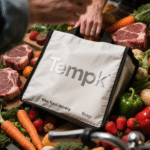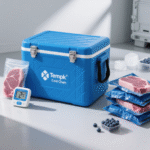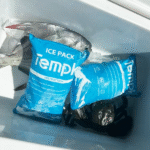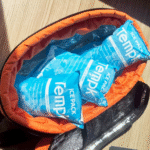What Is Cold Pack Dry Ice and How Does It Work for Temperature‑Sensitive Shipments?
Cold pack dry ice is an essential solution for maintaining low temperatures during transportation, especially when it comes to pharmaceuticals and perishable goods. In this guide, you’ll discover how dry ice works, when to use it, and expert tips to maximize its effectiveness for sensitive shipments.

-
How cold pack dry ice works to keep shipments at the right temperature
-
Best practices for packing and using dry ice for pharmaceuticals and food
-
2025 regulations for shipping with dry ice
-
The environmental impact of using dry ice and sustainable alternatives
-
Troubleshooting common issues when shipping with dry ice
How Does Cold Pack Dry Ice Work for Temperature‑Sensitive Shipments?
Cold pack dry ice is solid carbon dioxide that sublimates (changes from solid to gas) at –78.5°C. This creates an ultra‑cold environment ideal for shipping items that must remain frozen or chilled during transit. For example, dry ice is frequently used in shipping vaccines, blood samples, and frozen foods.
When placed in an insulated box, cold pack dry ice helps maintain a steady temperature, keeping contents well below freezing for long periods. Proper packing and ventilation are essential to avoid pressure build‑up inside the box.
Cold Pack Dry Ice Weight vs. Shipment Duration
| Shipment Size | Dry Ice (lb / kg) | Duration Below –10°C | Ideal Use |
|---|---|---|---|
| Small (5L) | 3 / 1.4 | ~12 hours | Ideal for 1‑2 day pharmaceutical deliveries |
| Medium (10L) | 5 / 2.3 | ~24 hours | Great for food shipping or short‑term biotech transport |
| Large (20L) | 10 / 4.5 | ~48 hours | Best for multi‑day shipments of vaccines or seafood |
Practical Tips
-
Use thick insulation around the dry ice pack for longer freezing periods.
-
Place cold items on top of dry ice to prevent direct contact, which could damage sensitive products.
-
Ventilate the shipping container to allow carbon dioxide gas to escape and avoid pressure build‑up.
Real‑Life Example: A medical supply company shipped gene therapy cells for 36 hours using 10 lb of dry ice in a 15L cooler, maintaining a temperature of –20°C throughout the trip.
When Should You Use Cold Pack Dry Ice for Pharmaceuticals or Food?
Cold pack dry ice is perfect for products that must be kept below freezing, such as biological materials, vaccines, and frozen foods. However, it’s important to understand which items can handle these extreme temperatures. For most biological products, a temperature of –20°C is optimal, but higher temperatures (e.g., 2–8°C) require alternative solutions, such as gel packs.
How to Choose Dry Ice vs. Gel Packs for Pharmaceuticals
| Temperature Need | Dry Ice | Gel Packs | When to Use |
|---|---|---|---|
| Freezing (–20°C) | ✅ | ❌ | Ideal for blood samples, vaccines, and biologics |
| Chilled (2–8°C) | ❌ | ✅ | Perfect for perishable food or temperature‑sensitive medications |
| Extended Shipping | ✅ | ✅ | Dry ice keeps things frozen, gel packs manage moderate temps |
User‑Focused Tips
-
For frozen food: Choose cold pack dry ice, especially for 48‑hour shipping to preserve texture and safety.
-
For vaccines: Opt for gel packs or temperature‑controlled packaging in combination with dry ice for extended trips.
-
For hybrid needs: Layer gel packs above the dry ice to regulate the temperature and prevent over‑freezing.
How to Pack Items with Cold Pack Dry Ice Correctly
-
Wear insulated gloves—dry ice is extremely cold and can cause burns.
-
Pre‑chill the shipping box by placing ice packs inside for an hour before packing.
-
Place dry ice at the bottom of the cooler box to ensure even cooling.
-
Wrap items in insulated material or place them in a temperature‑controlled pouch.
-
Seal the box loosely to allow gas to escape, and label it with the proper dry ice shipping tags.
-
Pack additional dry ice if shipping more than 24 hours, ensuring each box is tightly packed with minimal empty space.
Interactive idea: Check out our shipping calculator for cold chain solutions and dry ice needs for your specific shipment size.
2025 Dry Ice Shipping Regulations and Innovations
In 2025, air freight companies have adapted dry ice regulations, allowing for faster customs processing and more efficient global deliveries. Regulations now mandate the use of vented containers for dry ice to prevent gas buildup, and carbon‑composite boxes are being used to cut down on the sublimation rate by 12%.
Latest Highlights
-
Vented containers prevent pressure issues by allowing CO₂ gas to escape safely.
-
Carbon‑composite boxes have higher insulation properties, reducing dry ice consumption.
-
Biodegradable packaging innovations are becoming more common to reduce environmental impact.
Market insight: The global demand for temperature‑controlled logistics has increased by 14% in 2024, fueled by the rise in biologic drugs and online food deliveries.
Frequently Asked Questions {#faq}
Q: How long does dry ice last in an insulated cooler?
Dry ice typically lasts 18–24 hours depending on the insulation, shipment size, and outside temperature.
Q: Can I use dry ice with vaccines?
Yes, dry ice is commonly used for vaccines that need to be kept at subzero temperatures.
Q: Is dry ice safe to use for food shipping?
Yes—dry ice is safe for food shipping, especially for frozen and perishable items, as long as it is packed properly.
Q: How do I dispose of dry ice after shipping?
Allow it to sublimate in a well-ventilated area—do not store it in a sealed container.
Summary & Takeaways
Cold pack dry ice is the best solution for transporting items that need freezing temperatures, such as vaccines, biologics, and frozen foods. Ensure you follow proper packing guidelines, use the right shipping container, and adhere to the latest regulations to prevent damage or loss. For sensitive materials, dry ice remains a cost-effective, reliable option.
What to Do Next
-
Calculate your dry ice needs with our shipping calculator.
-
Order our latest cold chain packaging for seamless temperature regulation.
-
Share this guide to improve your cold chain shipping procedures.
About Tempk
At Tempk, we design temperature‑controlled packaging solutions to ensure the safe delivery of pharmaceuticals, food, and other sensitive products. With over 30 years of industry experience and cutting‑edge innovation, we deliver the highest quality cold chain solutions for businesses and individuals.
Need assistance with shipping logistics? Contact our expert team for tailored advice.























